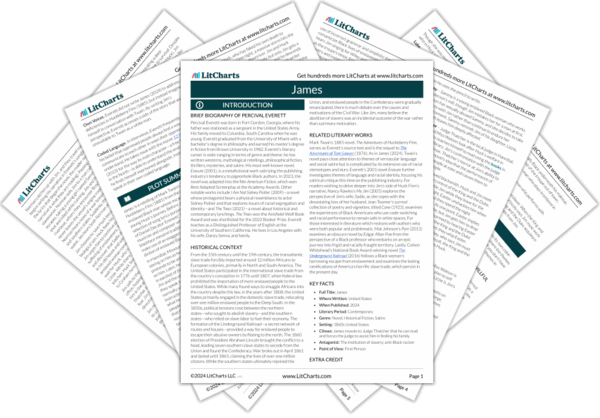James’s pencil represents his desire for and struggle to regain agency and self-determination as an enslaved person. Young George steals the pencil from his enslaver at Jim’s request, and the man implores him to “[t]ell the story with your ears. Listen.” Though Jim does not quite understand, he feels Young George’s advice is profound. Later, Jim witnesses Young George being beaten for stealing the pencil, and even later, hears that he was killed for the alleged crime, despite a lack of evidence. The cost of the pencil—Young George’s life—only makes it more precious to James, who feels compelled to write for the young man, whose voice has been silenced. With the pencil, Jim “wrote myself into being,” and renames himself “James.” Here, he reclaims his autonomy through the written word, which is itself a forbidden act for an enslaved person like himself. In his conversation with Easter, Jim senses his ability to write is a “call to duty,” referencing the feeling that he is in a war against enslavers and their supporters. He always keeps his pencil on him, even when he is sold to the enslaver Henderson, finding its presence comforts him. That the ability to affirm his own identity feels like security to Jim—a runaway slave, whose life is constantly endangered—is significant, demonstrating how his sense of self has become linked to his survival. In other words, Jim has begun to view himself not only as a man trying to survive war but as “a man who will not let his story be self-related, but self-written.” Ultimately, the reader realizes they are reading that very “self-written” tale, evidence that James has succeeded in determining his own legacy.
Pencil Quotes in James
Then I wrote my first words. I wanted to be certain that they were mine and not some I had read from a book in the judge’s library. I wrote:
I am called Jim. I have yet to choose a name.
[…]
But I will not let this condition define me. I will not let myself, my mind, drown in fear and outrage. I will be outraged as a matter of course. But my interest is in how these marks that I am scratching on this page can mean anything at all. If they can have meaning, then life can have meaning, then I can have meaning.
My name is James. I wish I could tell my story with a sense of history as much as industry. I was sold when I was born and then sold again. My mother’s mother was from someplace on the continent of Africa, I had been told or perhaps simply assumed. I cannot claim to any knowledge of that world or those people, whether my people were kings or beggars […] I can tell you that I am a man who is cognizant of his world, a man who has a family, who loves a family, who has been torn from his family, a man who can read and write, a man who will not let his story be self-related, but self-written.
With my pencil, I wrote myself into being. I wrote myself to here.
“White folks watch us work and forget how long we’re left alone in our heads. Working and waiting.”
I smiled. “If only they knew the danger in that.”
“I don’t believe they even know we talk to each other,” Easter said.
“They can’t accept it. They won’t accept it. And they’re always surprised.”












